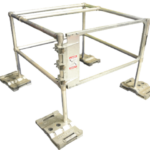Standard Hatch Guardrail Kits (4' x 4', 4' x 6')
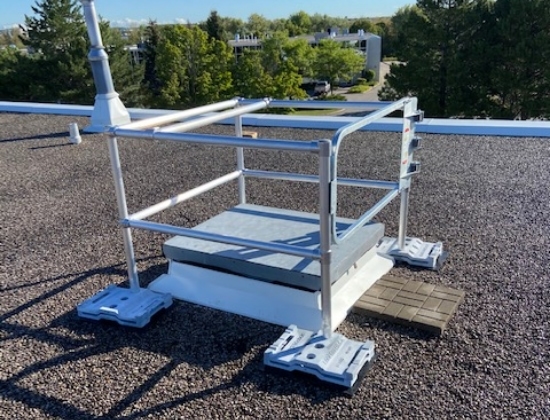
HatchGuard 4' x 4' Guardrail Kit
- Part Number: HG-KIT-08
- Height: 42” From Ground to Top of Top-Rail
- Shipping Dimensions: 4’ x 24” x 18”
- Diameter of Rail: 1.9” OD Aluminum Pipe
- Unit Weight: 450 lbs
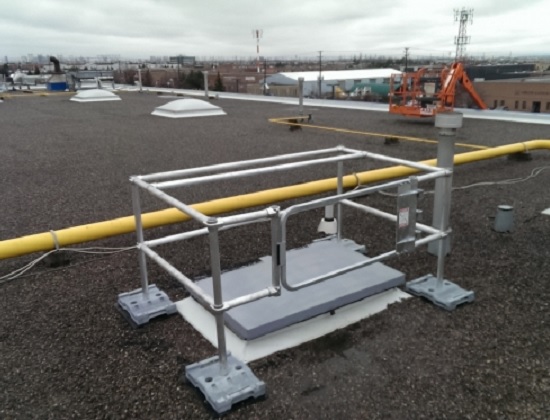
HatchGuard 4' x 6' Guardrail Kit
- Part Number: HG-KIT-4X6
- Height: 42” From Ground to Top of Top-Rail
- Shipping Dimensions: 4’ x 24” x 18”
- Diameter of Rail: 1.9” OD Aluminum Pipe
- Unit Weight: 500 lbs
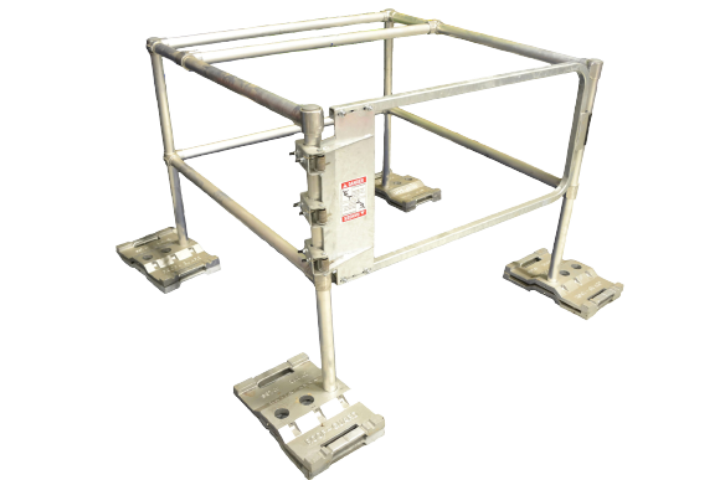
- Singular tool supplied for assembly
- Complete installation manual and layout drawings
- 8 counter weighted baseplates
- 4 rubber mats to protect rooftop membrane
- 4 pre-assembled vertical posts
- 7 horizontal rails
- Set screws
- All parts and materials are supplied on a single pallet
- Custom hatch systems are available upon request

- Height: 42” from ground to top of rail
- Shipping info (DIMS): 412 lbs
- Length: 70” wide (gate) by 68” deep assembled
- Diameter of rail: 1.9” OD aluminum pipe
- Unit weight: 450 lbs
- Singular tool supplied for assembly
- Complete installation manual and layout drawings
- 8 counter weighted baseplates
- 4 rubber mats to protect rooftop membrane
- 4 pre-assembled vertical posts
- 7 horizontal rails
- Set screws
- All parts and materials are supplied in a singular crate
- Custom systems available upon request

- Regulatory compliant
- Exceeds minimum strength requirements for railings
- Suitable for all roof hatches
- Rails serve as grab bars for easier roof access
- Integrates with existing hatch openings
- Galvanized finish is corrosion resistant aluminum

This system is designed to meet or exceed all major governing bodies fall protection requirements Including:
- Canada Labour Code: OH&S – Part 1.S2.5 (1)
- Canada Labour Code: OH&S – Part 12 S 12.07 (1)(2)(a)
- Canada Labour Code: OH&S – Part 12 S 12.07 (1)(2)(b)
- Canada Labour Code: OH&S – Part 12 S 12.07 (1)(2)(c)
A guide to understanding fall protection regulations and why you need Rooftop Guardrail.

See a full listing of our RoofGuard product line.
Frequently Asked Questions
When is fall protection required?
Employers must provide protection to prevent employees from falling. According to Canadian Centre for Occupational Health and Safety (CCOHS) laws, any surface 3 metres (10 feet) above another level requires fall protection. In most cases, fall protection is required when:
- other means of fall protection are not available or possible, such as guardrails
- working at a height of 3 metres or more (permanent and/or temporary work areas)
- working at a height of less than 3 metres when the surface below could cause a greater injury than just the fall (e.g., machinery; risk of drowning in water or other liquid; open tanks, vats, or pits containing hazardous materials; materials that can shift)
- a worker may fall through an opening in the work surface
- it is determined that fall protection is necessary
I don’t know if I need a rooftop guardrail system. Can Liftsafe Fall Protection help me decide?
For sure! Fall protection regulations can be tricky, so if you’re unsure whether a rooftop guardrail system is the right solution, we can help. Just click here to fill out the form with as much detail as possible and our team will get back to you as soon as possible for a complete consultation. You can also reach our team directly at:
Phone: 1-800-977-2005
Email: info@liftsafegroup.com
Do RoofGuard Guardrail Systems comply with current US/Canada safety regulations?
What is the difference between active and passive fall protection?
Both active and passive fall protection are effective in protecting workers from falling. However, while active protection requires involvement from the worker, passive systems can keep people safe regardless of training level and awareness of a hazard.
Active fall protection are known as Personal Fall Arrest Systems (PFAS), such as body harnesses, lanyards, and anchor points. Passive fall protection, alternatively, are physical barriers or systems, such as guardrails and safety nets, that prevent workers from falling or catch them if they do fall.
Passive solutions are always preferred to active ones. They represent engineering controls that keep people safe regardless of training level and awareness of a hazard.
How can I purchase RoofGuard Guardrail Systems from Liftsafe Fall Protection?
It’s pretty simple. Click here to request a quote and our team will get back to you as soon as possible. Don’t forget to fill out the form with as much detail as possible so we can provide a precise quote. You can also reach our team directly at:
Phone: 1-800-977-2005
Email: info@liftsafegroup.com
How long does it take to install a rooftop guardrail? Does it require any special tools or skills?
Roofguard is incredibly simple to install and can be easily installed by an inexperienced worker with simple hand tools and our instructions. Each system has labels that contain a QR code linking to a series of videos showing exactly how to install it for maximum time savings.
Are RoofGuard Guardrail Systems certified by an engineer?
Each RoofGuard system comes with a stamped engineering drawing back by the in-house engineering team at Liftsafe Fall Protection.
Are guardrails more expensive than horizontal lifeline systems?
While every system is different, at times the initial costs of guardrail can be slightly more compared to horizontal lifeline systems. However, you also need to consider the costs of certifying employees for working at heights (every three years), anchor point inspections (annually), lanyard and harness costs and inspections (annually), recordkeeping (ongoing), a rescue plan, and other related costs. When you take these into account, the overall cost of an installed guardrail system is much lower when compared to horizontal lifeline systems.
There is also the amount of time and resources that must be devoted to making sure these are all adhered to. Whereas, a guardrail system can be set up once and you are instantly compliant.
Are the materials used in the RoofGuard Guardrail Systems protected from corrosion and other environmental factors?
Yes. RoofGuard Guardrail Systems are typically made of aluminum, which ensure durability in diverse weather conditions. They are designed to be protected from corrosion, rust and other environmental factors, and its components contribute to resistance to environmental wear and tear.
How does the RoofGuard Guardrail stay in place if it isn't secured to the roof?
The RoofGuard Guardrail System is a modular, non-penetrating system designed to eliminate the potential hazard of falls over unprotected edges on a rooftop or elevated surface. It is counter weighted, which means it requires no welding, drilling, or bolting into the actual roof structure, and is designed to rest on top of it while still meeting lateral force requirements set out in the appropriate standards and laws.
Can RoofGuard Guardrail Systems be painted?
Yes. RoofGuard comes standard as an aluminum system that is grey but some clients prefer it to be painted safety yellow. This is done in-house with a powder coated paint that is weather resistant.
Can RoofGuard Guardrail Systems be used as an anchor?
No. RoofGuard must not be used as an anchor. This is stated explicitly in the RoofGuard installation manual among other safety requirements.
Can RoofGuard Guardrail Systems be installed on a sloped roof?
Yes. This depends on how steep the slope is for standard systems (it must meet the standards and regulations for sloped roofs). However, custom systems are available for multiple applications including sloped roofs.
Request a Quote
Why our Fall Prevention Systems are Right for You
All of the RoofGuard products are a cost-effective fall prevention solution.
All of our rooftop guardrail systems are designed in order to meet or exceed all North American Safety Standards.
With the addition of one of our rooftop fall prevention devices, you will be able to reduce PPE and training requirements of your staff and contractors.
All of our rooftop guardrail systems are safe and reliable fall prevention solutions.
Designed in order to be easily installed, many of our rooftop fall prevention systems can be installed with a single tool.
These fall prevention devices will help protect your employees from injury or death.
With the addition of a rooftop guardrail system, you will be able to reduce the potential for costly fines.
Every single one of the individual components used within these rooftop guardrail systems weighs under 40lbs.
The Hierarchy of Fall Protection Solutions
Elimination of Hazards
- Whenever possible, remove the fall hazard itself.
- If there is no fall hazard, there’s no fall.
Passive Systems
- Do not require the use of Personal Protective Equipment or active participation from the worker.
- Include Guardrails or Netting Systems.
- A preferred choice for its ease of use without the need for additional training and PPE.
Fall Restraint
- Uses personal fall arrest equipment (harness, lanyard, a. anchor point) to stop the user from reaching the edge.
- This type of ttying-offi p the user from falling in the first place.
Fall Arrest
- When all other solutions are infeasible.
- Fall arrest uses the same equipment as fall restraint but the fall protection equipment engages after the fall happens
- When it engages, the equipment slows the workers descent, bringing them to a safe stop.
Become A Dealer
Offer a wide range of high-quality engineered fall protection solutions to your customers.

Industrial Barrier Netting
Engineered vertical barrier netting systems around stacked boxes and walkways to provide protection against falling materials and a security barrier against potential theft.
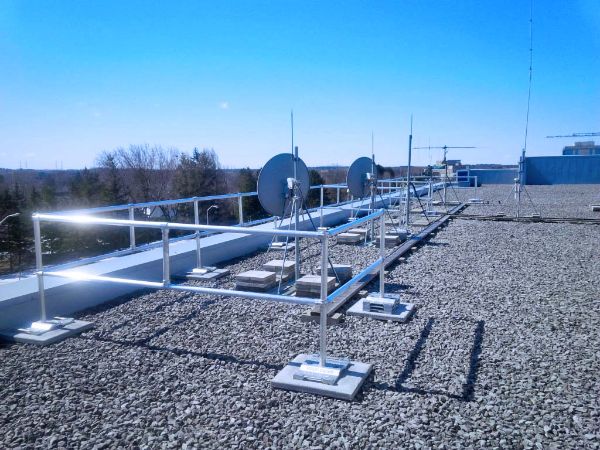
Roofguard Rooftop Guardrail
Modular rooftop guardrail systems designed to protect employees working at, or near, the leading edge while working at heights.
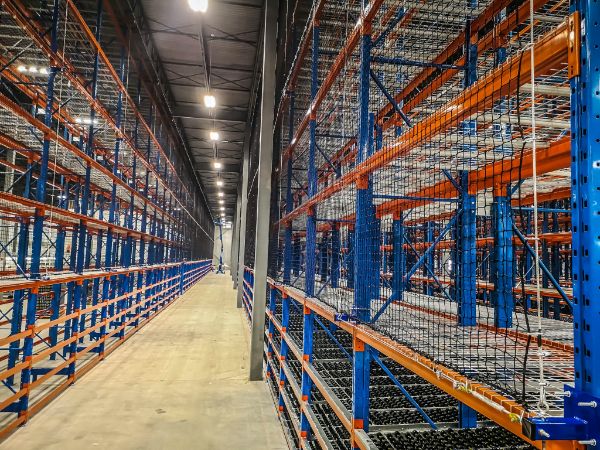
RackGuard Netting Systems
RackGuard netting is a cost-effective, engineered solution designed to make warehouses and industrial racking safer for employees and visitors by creating a “soft-catch” for products that fall from racking.
Related Products
About Liftsafe Fall Protection
Netting Catalogue
Customer Service
Request a quote
We offer a huge selection of products and quick quotes for what you’re looking for.


